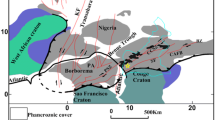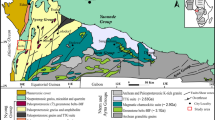Abstract
The Boam Li deposit in Uljin, South Korea, is a hard-rock Li deposit composed of albite-spodumene pegmatite and lepidolite-elbaite greisen. The timing of Li mineralization in the Boam deposit is poorly constrained due to a wide range of the mica K-Ar ages of the greisen from 176 to 127 Ma. We investigated the microstructure, mineral composition, and U-Pb age of zircons separated from the albite-spodumene pegmatite of the Boam Li deposit. Zircons are found as inclusions in spodumene and discrete grains intergrown with secondary albite, muscovite, columbite group mineral (CGM), microlite, and apatite, indicating that the zircon was saturated during the intrusion of pegmatite melt and subsequent greisenization of the Boam deposit. Most zircons have altered porous domains in cores mantled by overgrown rims with contrasting microstructures and chemical compositions. The porous domains in zircon cores contain Ca, Al, and Fe-bearing zircon solid solution, quartz, K-feldspar, muscovite, CGM, and microlite, which indicates pervasive alteration during greisenization. Higher U contents and Zr/Hf ratios of the core than the rim suggest that the melt from which the zircon cores crystallized was U-rich and less evolved. The overgrown rim domain with weak oscillatory zoning occurs in association with albite, muscovite, and apatite. Based on the microstructure and zircon compositions, we suggest that the SHRIMP U-Pb age of the zircons from the pegmatite indicates the timing of greisenization and Li mineralization in the Boam deposit. The zircon core and rim U-Pb isotope data constitute a single discordia line, yielding a weighted mean age of 172.4 ± 1.1 Ma (MSWD = 2.3). The age is consistent with the oldest mica K-Ar age of the lepidolite-elbaite greisen in Uljin.
Similar content being viewed by others
References
Bowell, R.J., Lagos, L., de los Hoyos, C.R., and Declercq, J., 2020, Classification and characteristics of natural lithium resources. Elements, 16, 259–264.
Bradley, D.C., Stillings, L.L., Jaskula, B.W., Munk, L.A., and McCauley, A.D, 2017, Chapter K: lithium. In: Schulz, K.J., DeYoung, J.H., Jr., Seal, R.R., II, and Bradley, D.C. (eds.), Critical Mineral Resources of the United States—Economic and Environmental Geology and Prospects for Future Supply. USGS Professional Paper, U.S. Geological Survey, Reston, USA, 1802, 21 p. https://doi.org/10.3133/pp1802K
Burt, D.M., 1981, Acidity-salinity diagrams; application to greisen and porphyry deposits. Economic Geology, 76, 832–843.
Černý, P., 1991, Fertile granites of Precambrian rare-element pegmatite fields: is geochemistry controlled by tectonic setting or source lithologies? Precambrian Research, 51, 429–468.
Cheong, W., Cho, M., and Kim, Y., 2013, An efficient method for zircon separation using the gold pan. Journal of Petrological Society of Korea, 22, 63–70. https://doi.org/10.7854/JPSK.2013.22.1.063
Cheong, A.C., Jo, H.J., Jeong, Y.-J., and Li, X.-H., 2019, Magmatic response to the interplay of collisional and accretionary orogenies in the Korean Peninsula: geochronological, geochemical, and O-Hf isotopic perspectives from Triassic plutons. GSA Bulletin, 131, 609–634.
Cho, M., Lee, Y., Kim, T., Cheong, W., Kim, Y., and Lee, S.R., 2017, Tectonic evolution of Precambrian basement massifs and an adjoining fold-and-thrust belt (Gyeonggi Marginal Belt) Korea: an overview. Geosciences Journal, 21, 845–865.
Choi, Y.-H., Park, Y.-R., and Noh, J.H., 2014, Genesis of Boam lithium deposits in Wangpiri, Uljin. Journal of the Geological Society of Korea, 50, 489–500. (in Korean with English abstract)
Claiborne, L.L., Miller, C.F., Walker, B.A., Wooden, J.L., Mazdab, F.K., and Bea, F., 2006, Tracking magmatic processes through Zr/Hf ratios in rocks and Hf and Ti zoning in zircons: an example from the Spirit Mountain batholith, Nevada. Mineralogical Magazine, 70, 517–543.
Claoué-Long, J.C., Compston, W., Roberts, J., and Fanning, C.M., 1995, Two Carboniferous ages: a comparison of SHRIMP zircon dating with conventional zircon ages and 40Ar/39Ar analysis. In: Berggren, W.A., Kent, D.V., Aubry, M.-P., and Hardenbol, J. (eds.), Geochronology, Time Scales and Global Stratigraphic Correlation. SEPM Special Publication, 54. https://doi.org/10.2110/pec.95.04.0003
Cluzel, D., 1992, Formation and tectonic evolution of early Mesozoic intramontane basins in the Ogcheon belt (South Korea): a reappraisal of the Jurassic “Daebo orogeny”. Journal of Southeast Asian Earth Sciences, 7, 223–235.
Geisler, T., Burakov, B.E., Zirlin, V., Nikolaeva, L., and Pöml, P., 2005, A Raman spectroscopic study of high-uranium zircon from the Chernobyl “lava”. European Journal of Mineralogy, 17, 883–894.
Geisler, T., Schaltegger, U., and Tomaschek, F., 2007, Re-equilibration of zircon in aqueous fluids and melts. Elements, 3, 43–50.
Kang, H.K., Oh, S.B., and Kim, H.S., 1998, Time-relationship between deformation and Metamorphism of the Paleozoic metasedimentary rocks of the north Sobaegsan massif in the Janggun bong area, Korea. Journal of the Petrological Society of Korea, 7, 190–206. (in Korean with English abstract)
Kim, J. and Cho, M., 2003, Low-pressure metamorphism and leucogranite magmatism, northeastern Yeongnam Massif, Korea: implication for Paleoproterozoic crustal evolution. Precambrian Research, 122, 235–251.
Kim, O.J., Hong, M.S., Kim, K.T., and Park, H.I., 1963, Explanatory text of the geological map of Samgun-ri sheet (1:50,000). Korea Research Institute of Geoscience and Mineral Resources, Seoul, Korea, 36 p. (in Korean with English abstract)
Kim, S.W., Kwon, S., Park, S.I., Lee, C., Cho, D.L., Lee, H.J., Ko, K., and Kim, S.J., 2016, SHRIMP U-Pb dating and geochemistry of the Cretaceous plutonic rocks in the Korean Peninsula: a new tectonic model of the Cretaceous Korean Peninsula. Lithos, 262, 88–106.
Lee, D.W., 1988, Lithogeochemical characteristics of granitoids in relation to tin mineralization in the Sangdong and Ulchin areas, Korea and their applicability to tin exploration. Seoul National University, Ph.D. Thesis, Seoul, Korea, 153 p. (in Korean with English abstract)
Lee, G., Kim, S.-Y., and Koh, S.-M., 2013, Potential evaluation of the Uljin lithium deposit. Minerals and Industry, 26, 32–36. (in Korean)
Lee, H.G., Moon, H.S., and Oh, M.S., 2007, Economic Mineral Deposits in Korea (1st edition). Acanet, Seoul, Korea, 762 p.
Lee, Y.I., Choi, T., and Orihashi, Y., 2011, LA-ICP-MS zircon U-Pb ages of the Precambrian Yuli Group. Journal of the Geological Society of Korea, 47, 81–87. (in Korean with English abstract)
Linnen, R.L. and Keppler, H., 2002, Melt composition control of Zr/Hf fractionation in magmatic processes. Geochimica et Cosmochimica Acta, 66, 3293–3301.
London, D., 2014, A petrologic assessment of internal zoning in granitic pegmatites. Lithos, 184, 74–104.
Ludwig, K.R., 2008, User’s manual for Isoplot 3.6: a geochronological toolkit for Microsoft Excel. Berkeley Geochronology Center Special Publication 4, Berkeley, USA, 77 p.
Ludwig, K.R., 2009, User’s manual for Squid 2.50. Berkeley Geochronology Center Special Publication 5, Berkeley, USA, 110 p.
Moon, S.H., Park, H.-I., Ripley, E.M., and Lee, I., 1996, Mineralogic and stable isotope studies of cassiterite greisen mineralization in the Uljin area, Korea. Economic Geology, 91, 916–933.
Oh, I.-H., Yang, S.-J., Heo, C.-H., Lee, J.-H., Kim, E.-J., and Cho, S.-J., 2022, Study on the controlling factors of Li-bearing pegmatite intrusions for mineral exploration, Uljin, South Korea. Minerals, 12, 589.
Paces, J.B. and Miller Jr, J.D., 1993, Precise U-Pb ages of Duluth complex and related mafic intrusions, northeastern Minnesota: geochronological insights to physical, petrogenetic, paleomagnetic, and tectonomagmatic processes associated with the 1.1 Ga midcontinent rift system. Journal of Geophysical Research: Solid Earth, 98, 13997–14013.
Park, G., Park, J.-W., and Heo, C.-H., 2022, Mineral geochemistry of the albite-spodumene pegmatite in the Boam deposit, Uljin. Korean Journal of Mineralogy and Petrology, 35, 283–298. (In Korean with English abstract) https://doi.org/10.22807/KJMP.2022.35.3.283
Park, H.-I., Chang, H.W., and Jin, M.S., 1988, K-Ar ages of mineral deposits in the Taebaeg mountain district. Economic and Environmental Geology, 21, 57–67. (in Korean with English abstract)
Park, K.-H., Kim, M.J., Yang, Y.S., and Cho, K.O., 2010, Age distribution of the Jurassic plutons in Korean peninsula. Journal of the Petrological Society of Korea, 19, 269–281. (in Korean with English abstract)
Pirajno, F., 1992, Hydrothermal Mineral Deposits. Springer, Berlin, Germany, 709 p.
Schaltegger, U., 2007, Hydrothermal zircon. Elements, 3, 51–79.
Soman, A., Geisler, T., Tomaschek, F., Grange, M., and Berndt, J., 2010, Alteration of crystalline zircon solid solutions: a case study on zircon from an alkaline pegmatite from Zomba-Malosa, Malawi. Contributions to Mineralogy and Petrology, 160, 909–930.
Song, Y.-S. and Yi, K., 2015, SHRIMP U-Pb age of the Chunyang granite, NE Yeongnam massif, Korea. Journal of the Geological Society of Korea, 51, 397–402. (in Korean with English abstract)
Stacey, J.S. and Kramers, J.D., y, Approximation of terrestrial lead isotope evolution by a two-stage model. Earth and Planetary Science Letters, 26, 207–221.
Štemprok, M., 1987, Greisenization (a review). Geologische Rundschau, 76, 169–175.
U.S. Geological Survey, 2022, Mineral commodity summaries 2022. USGS Report, U.S. Geological Survey, Reston, USA, 202 p. https://doi.org/10.3133/mcs2022
Van Lichtervelde, M., Melcher, F., and Wirth, R., 2009, Magmatic vs. hydrothermal origins for zircon associated with tantalum mineralization in the Tanco pegmatite, Manitoba, Canada. American Mineralogist, 94, 439–450.
Vermeesch, P., 2018, IsoplotR: a free and open toolbox for geochronology. Geoscience Frontiers, 9, 1479–1493.
Williams, I.S., 1998, U-Th-Pb geochronology by ion microprobe. In: McKibben, M.A., Shanks III, W.C., and Ridley, W.I. (eds.), Applications of Microanalytical Techniques to Understanding Mineralizing Processes. Reviews in Economic Geology, Society of Economic Geologists, 7, p. 1–35. https://doi.org/10.5382/Rev.07.01
Williams, I.S. and Hergt, J.M., 2000, U-Pb dating of Tasmanian dolerites: a cautionary tale of SHRIMP analysis of high-U zircon. Proceedings of Beyond 2000: New Frontiers in Isotope Geoscience, Lorne, Australia, Jan. 30–Feb. 4, p. 185–188.
Yoo, J.H., Koh, S.M., and Moon, D.H., 2012, Introduction of several albitite-greisen type deposits of Korea. Korean Journal of Mineralogy and Petrology, 25, 221–231.
Yoon, R., Song, Y.-S., and Yi, K., 2014, SHRIMP U-Pb zircon ages of the Yeongju and Andong granites, Korea and their implications. The Journal of the Petrological Society of Korea, 23, 209–220.
Acknowledgments
We thank Il-Hwan Oh for his help in the field survey, sampling, and preparation of the zircon U-Pb analysis. Sarang Choi, Gyuchan Park, Sunghwan Im, Jihyuk Kim, Bongju Kim, and Jiwon Hwang are thanked for their help in field surveys and sampling. We also thank Sin-Ae Lee and Keewook Yi for scientific and technical assistance in using a sensitive high-resolution ion microprobe. This work was supported by the Korea Institute of Geoscience and Mineral Resources (KIGAM) commissioned research project “Developing exploration tools for LCT-pegmatite deposits using LA-ICP-MS technique” of the basic research project “Development of precise exploration technology for energy storage minerals (V) existing in Korea and the resources estimation (GP2022-008)”. A part of this research is funded by National Research Foundation of Korea (NRF-2022R1A2C1011741).
Author information
Authors and Affiliations
Corresponding author
Additional information
Publisher’s Note
Springer Nature remains neutral with regard to jurisdictional claims in published maps and institutional affiliations.
Electronic supplementary material
Rights and permissions
About this article
Cite this article
Park, G., Park, JW. & Heo, CH. The SHRIMP zircon U-Pb geochronology and microstructural study of the albite-spodumene pegmatite from the Boam Li deposit in Uljin, South Korea. Geosci J 27, 479–489 (2023). https://doi.org/10.1007/s12303-023-0006-9
Received:
Accepted:
Published:
Issue Date:
DOI: https://doi.org/10.1007/s12303-023-0006-9




